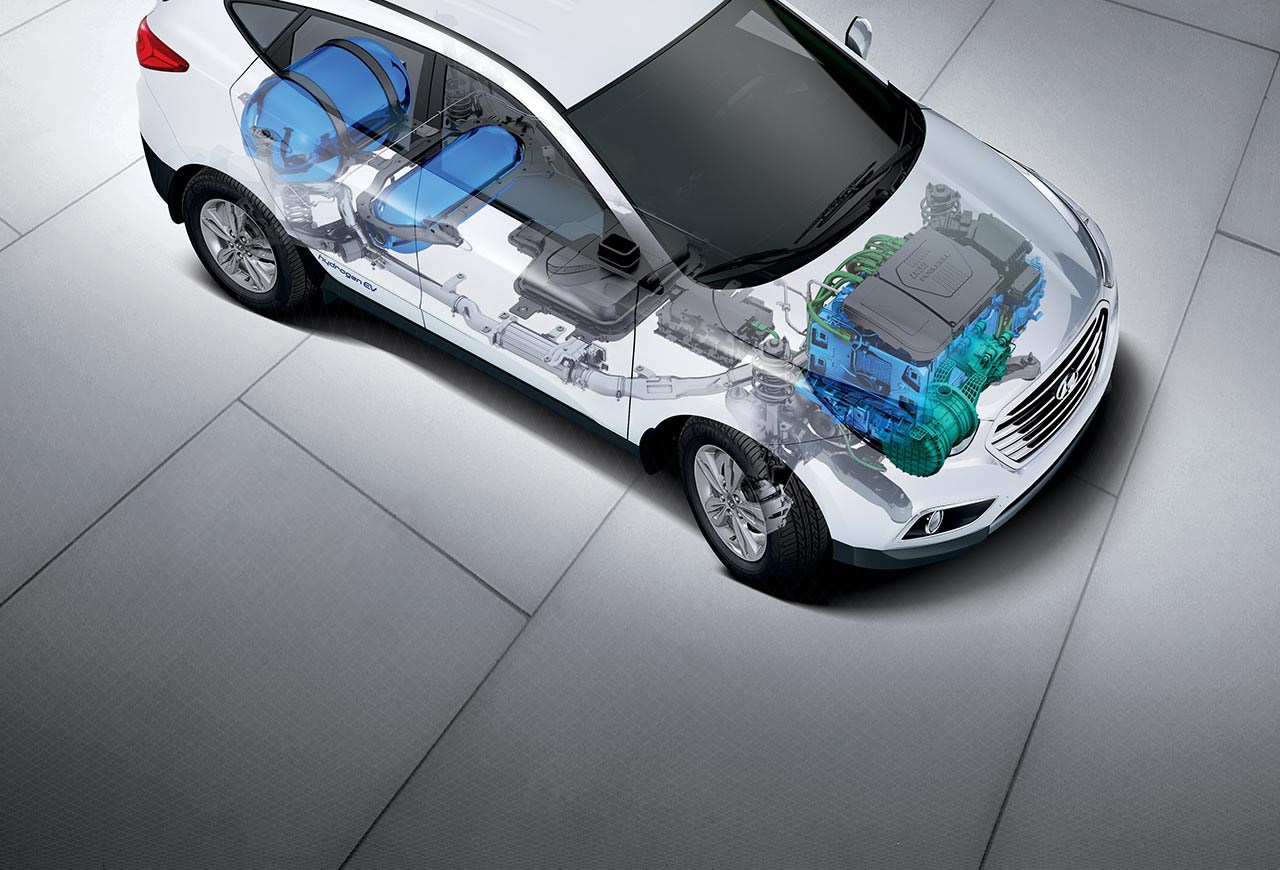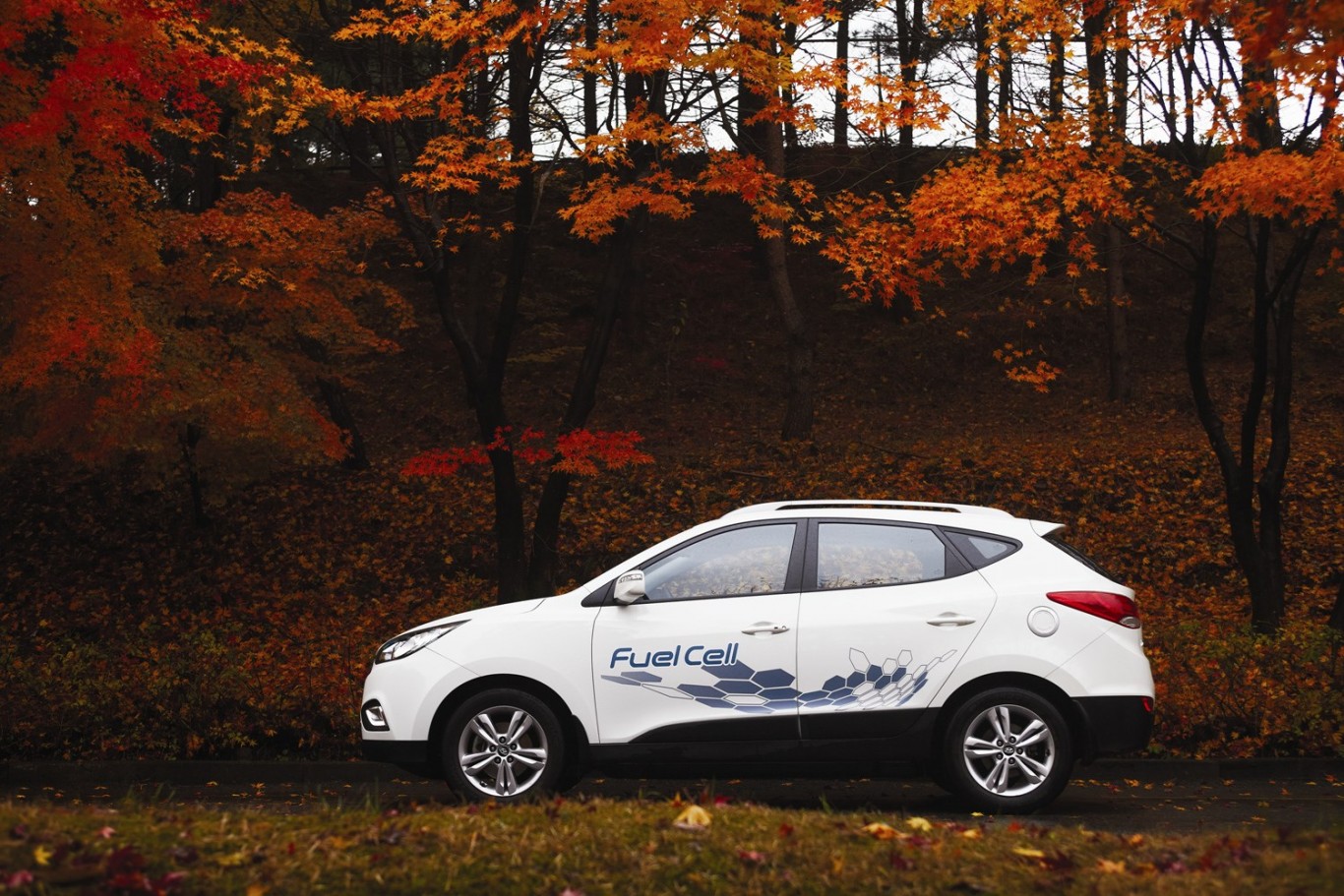Researchers at Delft University of Technology (TU Delft) in the Netherlands engineered and installed an electrical outlet socket on a Hyundai ix35 Fuel Cell Vehicle that converts the zero-emission fuel cell electric vehicle (FCEV) into a power plant when standing still.
In close collaboration with Hyundai Motor Company and other commercial partners, their conversion gave the Hyundai ix35 Fuel Cell a capacity of 10 kW, sufficient to power on average ten homes.
With the electrical outlet socket in place, the innovators modified the car in such a way that it can distribute its electricity to the grid or directly to a house, for instance to complement the available wind and solar power.
“The researchers led by professor Ad van Wijk at TU Delft are the first ones in Europe who have managed to make the next big step towards a more sustainable future based on fuel cell cars as a clean source of energy,” says Frank Meijer, head of Fuel Cell Electric Vehicle at Hyundai Motor Europe. “Fuel cell cars produce electricity, heat and clean water out of hydrogen that can be used in homes, schools and offices and we are particularly proud that the first car to provide that kind of clean energy is a Hyundai Motor ix35 Fuel Cell.”
A car as a power plant
Professor Ad van Wijk’s research group is called Future Energy Systems and belongs to the Process & Energy department at the faculty of mechanical, maritime and materials engineering (3mE). Their work is focused on integrated system applications of the fuel cell, as for example in the programme ‘Car as Power Plant’.
The idea is that car owners use their vehicles for transportation only 5% of the time. Unlike a fossil fuel powered car, a fuel cell vehicle, when parked, can produce electricity from hydrogen – cleaner and more efficiently than the current electricity system and with useful “waste” products heat and fresh water.
These applications will be researched and tested in the next stage of the programme. The project is part of the Greenvillage intiative (http://www.thegreenvillage.org/) of the TU Delft to promote innovative systems for a sustainable future.
ix35 Fuel Cell Vehicle success continues in United Kingdom
And in the United Kingdom the success story of Hyundai Motor’s hydrogen venture continues as Aberdeen City Council and Co-wheels car club added four ix35 Fuel Cells to their fleet of models. The cars will be made available to the public through the car club on a pay-as-you-go basis and to Aberdeen businesses for trial.
This order takes the nationwide total of Hyundai ix35 Fuel Cell vehicles to 15 with more than 250 across Europe. Those vehicles in the UK are already in use by Johnson Matthey, TfL, Air Products, ITM Power and Anglo American.
Hyundai Motor UK CEO, Tony Whitehorn said: “As more and more cities throughout the UK begin to improve their hydrogen facilities, we’re seeing greater demand for our ix35 Fuel Cell. It’s fantastic to be a part of Aberdeen’s hydrogen development in this way, especially because the cars are going to be used on a day-to-day basis by members of the public. We want them to experience all the reasons why we think hydrogen is the way forward in terms of usability, refinement and ultra-clean motoring.”
Aberdeen City Councillor Barney Crockett, who also chairs the European hydrogen association HyER, added: “Aberdeen is developing a reputation as a ‘can-do’ hydrogen city. With these cars, we are taking things to the next level, moving ever closer to becoming a world-leading renewables city and securing a hydrogen economy in Aberdeen, presenting tangible opportunities to the energy industry.”
In addition, as part of the UK’s Hydrogen Week (March 14-18, 2016), the government-backed London Hydrogen Network Expansion project (LHNE) – of which Hyundai Motor is a partner – broke two new distance records for hydrogen fuel cell vehicles driving in the ix35 Fuel Cell.
The first record was for the longest journey in the UK on a single tank of hydrogen – travelling 653 km – and the second was for the longest continuous journey made in a fuel cell vehicle by travelling 9 811 km over 50 laps of the M25 highway in six days.
The ix35 Fuel Cell is the first hydrogen car to go on sale to the public in the UK. It has a range of 525 km but emits only water and has a refueling time to match a combustion-engined car.
LHNE, co-funded by Innovate UK, was set up in 2012 to create the UK’s first hydrogen-powered transport system across London and the South East. It has delivered a new publicly-accessible, state-of-the-art fast-fill Air Products SmartFuel® hydrogen refuelling station and upgraded a second to the requisite 700 bar pressure status.
The LHNE partners are now keen for the adoption of hydrogen fuel cell technology to accelerate in the UK, but one of the main challenges is the limited coverage of refuelling stations to support the vehicles.
There are currently 6 stations in the UK, including the 2 public Air Products SmartFuel® stations in London. Funding is in place for at least 12 to be operational in England and Scotland within the next 12 months.
A leader in fuel cell technology
The ix35 Fuel Cell is the world’s first mass-produced and commercially available fuel cell electric vehicle. FCEVs are not a newly developed technology for Hyundai. The ix35 Fuel Cell is already the fourth generation of FCEV, following the Santa Fe FCEV in 2000, the Tucson FCEV in 2004 and the ix35 FCEV in 2012.



























